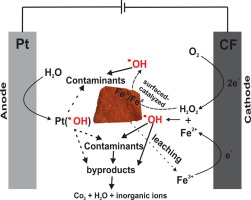Separation and Purification Technology ( IF 8.1 ) Pub Date : 2020-02-29 , DOI: 10.1016/j.seppur.2020.116776 Soliu O. Ganiyu , Emily C.T. de Araújo Costa , Carlos A. Martínez-Huitle , Elisama V. dos Santos

|
In this study, electro-Fenton (EF) process catalysed by iron-rich laterite has been investigated for the degradation of food colorant Bordeaux Red (E123). The laterite was characterized and the effect of catalyst dosage, calcination temperature, initial solution pH and concentration as well as applied current on the decay of the organic matter during the treatment of E123 solution was evaluated. The characterization results showed that the laterite consists of over 30% iron oxides along with significant amount of Al2O3, TiO2 and SiO2. Strong oxidant, major hydroxyl radical (•OH) was generated in the solution from both homogeneous and heterogeneous catalytic decomposition of electrogenerated H2O2 by Fe3+/Fe2+ redox couple leached into the solution and at the surface of the solid iron oxides. The mineralization efficiency of the process was enhanced by increasing the catalytic dosage up to 8.5 g L–1, calcination temperature up to 400 0C and applied current in the range of 50 – 250 mA, whereas lower COD removal was observed with an increase on the initial solution pH and colorant concentration. At optimum conditions (8.5 g L–1 dosage, 400 0C calcination temperature, 0.5 mM initial E123 concentration, pH 3 and applied current of 250 mA using platinum anode and carbon-felt as cathode), complete COD removal (100%) was achieved in less than 4 h of electrolysis, demonstrating the high potential of the laterite-catalysed heterogeneous electro-Fenton (HEF) process for the remediation of organic pollutants.
中文翻译:

富铁红土催化电芬顿处理食用色素波尔多红(E123):催化剂表征,操作条件优化和氧化机理
在这项研究中,已经研究了富铁红土催化的电子芬顿(EF)工艺对食用色素波尔多红(E123)的降解。对红土进行了表征,并评估了催化剂用量,煅烧温度,初始溶液的pH和浓度以及施加的电流对E123溶液处理过程中有机物降解的影响。表征结果表明,红土由30%以上的氧化铁以及大量的Al 2 O 3,TiO 2和SiO 2组成。电生成的H 2的均相和非均相催化分解在溶液中生成强氧化剂,主要羟基自由基(• OH)Ó 2的Fe 3+ / Fe的2+氧化还原对浸出到溶液中,并在固体铁氧化物的表面上。通过增加催化剂量至8.5 g L –1,煅烧温度至400 0 C和施加电流50 – 250 mA,可提高该过程的矿化效率,而随着COD的增加,COD去除率降低。初始溶液的pH值和着色剂浓度。在最佳条件下(8.5 g L –1剂量,400 0C煅烧温度,E123初始浓度为0.5 mM,pH 3,施加电流250 mA(使用铂阳极和碳毡作为阴极),在不到4小时的电解时间内就完全去除了COD(100%),表明了高电势红土催化的非均相电芬顿(HEF)工艺用于有机污染物的修复。











































 京公网安备 11010802027423号
京公网安备 11010802027423号